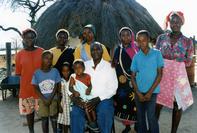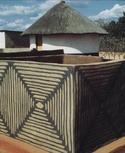Developing Tribe
The first Tsonga-speakers to enter the former Transvaal probably did so during the 18th century. They were essentially traders who followed rivers inland, where they bartered cloth and beads for ivory, copper and salt. In the early 1820s, they were joined by co-linguists pushed from the coast by Nguni raiders.

At this time the Tsonga living on the coastal plain constituted a loose cluster of linguistically related peoples who shared a few distinguishing customs but had no single governing identity. Their small groups could offer only limited resistance to the invading Nguni.
The last Nguni group to come to the area was a remnant of the Ndwandwe army, under Shoshangane, which had suffered a mauling at the hands of Shaka and his Zulu impis on the Mhlatuze River banks, near present-day Ulundi.
The refugees settled along the Tembe River, south-east of what is today Swaziland, but before long they turned on the Tsonga, moving north in a gentle sweep to the Limpopo Valley. An uneasy peace developed as the Ndwandwe, or Shangaan, began to incorporate Tsonga-speakers into their ranks.
Shoshangane
A Nguni state on Zululand's northern border was an irritation to the Zulu, serving as a home for political dissidents and threatening the important trade route to Lourenço Marques, now Maputo. A new Zulu expedition was sent north in 1833 to attack Shoshangane and punish his allies. They seized Lourenço Marques and impaled the governor of the town on the beach.
In the face of this Zulu resurgence, Shoshangane and his followers fled from their settlement in the lower Limpopo Valley. They advanced to the Zambezi River before going south to settle in Mosapa, Zimbabwe. From here Shoshangane began to subdue and incorporate the Shona-speaking Ndau.
Using his expanded forces, he strengthened his power over the area between the Zambezi River and Delagoa Bay. Steadily the Gaza kingdom, named in honour of Shoshangane's grandfather who had lived in the Mkuze district of Zululand, began to emerge along the eastern edge of the escarpment and in the steamy bush of the coastal plain. A period of relative peace ensued, during which the Ndwandwe from the south and the Tsonga, who had been in the region for centuries, steadily influenced each other.
This was intensified after 1838 when many of Shoshangane's soldiers died in a smallpox epidemic, and he moved back to the Limpopo Valley. His troops devastated the area, as he punished his enemies, enslaved women and children, and demanded heavy payments of tribute. This turmoil dislodged two streams of refugees from the coastal plain.
The Nkuna and other small groups moved west along the Olifants River to place themselves under the Sotho-speaking tribes, Kaha and Lovedu, on the western Lowveld.
Second Wave of Refugees
The second wave of refugees - Maluleke, Baloyi, Tshauke and Sono - followed the Limpopo to settle along the Levubu 'Pafuri' River or in the lowlands to the east of the Soutpansberg and the Drakensberg. Small bands of refugees retained their chiefs by settling in inhospitable, high malaria risk areas but, if they wished to live around the healthier highlands they had to seek the protection of leaders like the Sotho-speaking Modjadji, Podile and Maake in the south or the Venda-speaking Pafuri in the north.
In the 1850s Tsonga immigrants made their home in the Spelonken foothills of the Soutpansberg where a Portuguese adventurer, Joäo Albasini, was building a personal kingdom out of profits made from the sale of slaves and ivory. While the Tsonga refugees in the interior started to form small communities, their kinsmen on the coast had to withstand continuing political upheavals.
In 1858 Shoshangane died and the kingdom began to disintegrate as his sons, Muzila and Mawewe, locked horns over the throne. Shoshangane had named Muzila as successor, which Mawewe contested; this led to almost 10 years of continuous fighting. Aided by Albasini and traders at Lourenço Marques, Muzila gained the upper hand. Mawewe fled to Swaziland, where he sought the help of King Mswati l, finally settling in northern Swaziland on the border with Gazaland.
Muzila had shifted the centre of the Gaza state back to the safety of Mosapa, leaving the Delagoa Bay hinterland unprotected. Each winter the Swazi launched devastating raids into the area. In 1884 Muzila died and his son, Gungunyana, succeeded him.
The new king rapidly tried to re-establish control over southern Gazaland. In 1889 he moved his capital to the lower Limpopo, colonizing the southern reaches of his empire. The ensuing disruption initiated a new wave of immigration into the Transvaal and brought Gungunyana into conflict with the Portuguese.
New Wave of Emigration

As the natural port for the Witwatersrand, Lourenço Marques had grown with the newly discovered gold fields. This gave the Portuguese the desire and means to establish control over southern Mozambique; in 1895 an expedition from Lisbon defeated Gungunyana and exiled him to the Azores.
His son, Thulilamahanxi, then a minor, and the regent, Mpisane, fled to the Transvaal Republic and settled north of the Sabi River along the foothills of the Drakensberg mountain range, in the present district of Mhala. The crushing of the Gaza was completed two years later when an uprising led by one of Gungunyana's generals was mercilessly subdued.
This initiated a new wave of emigration as the remnants of the Gaza empire crossed the border and entered the Transvaal. In 1910 Mpisane renounced his regency in favour of Thulilamahanxi, who was recognized by the family council as heir in the absence of the still exiled Buyisonto, the legitimate successor to Gungunyana. In 1922 Buyisonto came out of exile and moved to Mhala to become the leader of the descendants of the old Gaza kingdom.
By this time Tsonga-speakers constituted about four percent of the total South African population. In the Transvaal they lived in distinct areas. In the north, quite large chiefdoms, such as those of Xikundu, Mhinga, Xigalo and Makuleke, occupied reserves adjoining or near the Kruger National Park. Further south, scattered communities eked out a living in the Lowveld. Near the headwaters of the Levubu and Small Letaba rivers, Christian converts stayed on Swiss Mission farms at Valdezia, Elim and Kurulen, their children attending the celebrated Lemana College.
Further south, the Nkuna and several small groups lived on the edge of the Escarpment. The descendants of the Nguni-speaking Shangaans, with their Tsonga-speaking wives and followers, occupied the land between Acornhoek-Bushbuckridge and the southern end of the Kruger Park.
Probably the largest single group of Tsonga-speakers was in the Ingwavuma—Ubombo districts of northern Zululand. These were the descendants of the Maputo 'Mabudhu' in Zulu, whose kingdom was cut in two by the border between South Africa and Mozambique. Unlike the Tsonga in the Transvaal, they had close ties with the Zulu.